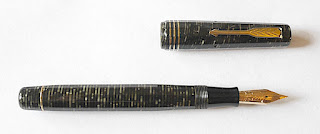Alabama’s Black Belt is s broad swath of land that spans
southern Alabama. Contrary to many assumptions it has nothing to do with the
ethnicity of the region, which is indeed, predominantly African-American, but
describes the richness of the soil which is best used for timbering, pasturing
and soybean production.
Saturday saw us leave the Mississippi Delta and Gulf Coast for the heart of
Dixie. We were not interested in getting to Birmingham, our next destination
quickly so much as to see the countryside. And we succeeded. Google maps
allowed me to set a route using secondary and tertiary roads (mostly along US
43 and AL 5). After a short tussle, the car’s GPS accepted the route.
I knew I done well when early in the drive we came across an
old building that was flanked by a series of newer church buildings. I swung
off 43 into a parking lot, grabbed the camera and began shooting. At the other
end of the compound was a truck and an historic plaque. A church member and the
marker told us the story of St. Peter the Apostle Catholic Church which was, to
oversimplify, the center of a Creole community that dated back to the late 18th
century. The town of Mount Vernon was the center and for the next hour we
followed their history trail ending up on an obscure Choctaw reservation, made
up of folks who had kept themselves apart from the forced migrations of the 19th
century. I had taught some of this stuff, now it was before me.
As we drove northward we came into the Black Belt. The first
hint was not markers but when I stepped out of the car to take a picture and
Sharon noted that she could smell the earth. As we drove through the area we
noted the neat farms, both those prosperous and less so, often cheek by jowl,
as it were. We did pass one or two houses indicated as former plantations, but
those were of less interest to us than how folks live and work today.
This was exactly the sort of thing I had hoped to experience
during this part of the trip, a new experience apart from that of the Delta and
its cities and the Gulf coast. So all in all a fairly happy day spent touring
south central Alabama. We arrived in Birmingham late in the afternoon. Sunday
will be a housekeeping and familiarization day before, on Monday, we set off on
Alabama’s civil rights history trail.
 |
| If you expand this image you can get a sense of what we toured |
 |
| This was the old parish hall built, we were told, probably in the 1920s. It served as a school, maternity hospital and, I am guessing, for whatever purposes the parish needed it to be. Note the brick oven to the side. The parish is trying to get funds to restore it. |
 |
| The current buildings. |
 |
| The train station at Mount Vernon, the community built around that original Creole settlement. |
 |
| In purple, the Black Belt |
 |
| These two photos represent a settlement by a crossroads |
 |
| One of the more prosperous farms we saw |
 |
| A nice house |

















Comments